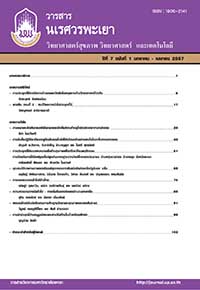การยับยั้งปฏิกิริยาฮีแมกกลูติเนชันของไวรัสไข้หวัดนกด้วยสารเพอไรโอเดตในหลอดทดลอง
Keywords:
ไวรัสไข้หวัดนก, เพอไรโอเดตออกซิเดชัน, กรดไซอะลิก, ฮีแมกกลูติเนชัน อินฮิบิชัน, Avian Influenza virus, periodate oxidation, sialic acid, hemagglutination inhibitionAbstract
กรดไซอะลิก หรือ N-acetylneuraminic acid (Neu5Ac, NANA) เป็นน้ำตาลโมเลกุลเดี่ยวที่มีคาร์บอนจำนวน 9 อะตอม ทำหน้าที่เป็นตัวรับของไวรัสไข้หวัดใหญ่ ชนิดเอ ในขั้นตอนการจับระหว่างเซลล์เยื่อเมือกของโฮสต์กับฮีมแมกกลูตินินของไวรัสซึ่งเป็นขั้นตอนแรกของการติดเชื้อไวรัสไข้หวัดใหญ่ สารเพอไรโอเดต (NaIO4) สามารถออกซิไดซ์ NANA ในมิวโคโปรตีนในอัตราส่วนโมล่าร์ระหว่าง NaIO4 ต่อกรดไซอะลิกที่ 1:1 - 1:4 NANA จะเปลี่ยนไปเป็นอนุพันธ์ของ NANA ที่มีจำนวนคาร์บอน 8 และ 7 ตัว ตามลำดับ เป็นสิ่งที่น่าสนใจว่าการเปลี่ยนแปลงโครงสร้างทางเคมีของ NANA จะมีผลกระทบต่อการจับกับฮีมแมกกลูตินินของไวรัสหรือไม่และอย่างไร ในการศึกษาครั้งนี้ใช้มิวโคโปรตีนจากน้ำลายนกนางแอ่น (Collocalia mucoid, CM) ต่อมน้ำลายไก่และหลอดลมไก่เป็นสารตัวรับของเชื้อไวรัสไข้หวัดนกสายพันธุ์ A/duck/Phitsanulok/NIAH6-5-0001/2007 (H5N1) ปริมาณกรดไซอะลิกทั้งหมดในตัวอย่างตรวจวัดด้วยวิธี standard Ehrlich’s method พบว่า CM มีกรดไซอะลิกมากที่สุด คือ ร้อยละ 10.27 รองมาเป็นต่อมน้ำลายไก่ ส่วนหลอดลมไก่นั้นพบปริมาณน้อยที่สุดคิดเป็นร้อยละ 1.24 และ 0.31 ตามลำดับ เมื่อนำมาทดสอบความสามารถในการจับกับเชื้อไวรัสด้วยวิธี hemagglutination inhibition (HI) พบว่ามีเพียงมิวโคโปรตีนจาก CM เท่านั้นที่เป็นสารยับยั้งปฏิกิริยาได้ (HI titer = 64) เมื่อ NANA ใน CM ถูกออกซิไดซ์ด้วย NaIO4 เปลี่ยนเป็นอนุพันธ์ของ NANA แล้วจะทำให้ modified CM ไม่สามารถจับกับไวรัสต่อไปได้ เพราะว่า modified CM ไม่สามารถยับยั้งปฏิกิริยาฮีมแมกกลูติเนชันของไวรัสไข้หวัดนกได้ดังเดิม ผลการทดลองชี้ให้เห็นว่าเมื่อเปลี่ยนแปลงโครงสร้างของกรดไซอะลิกด้วยสารเพอไรโอเดต อนุพันธ์ของ NANA จะไม่สามารถรวมตัวกับไวรัสไข้หวัดนกได้ ดังนั้นการเปลี่ยนแปลงโครงสร้างของ NANA ซึ่งเป็นตัวรับของไวรัสไข้หวัดนกในระบบทางเดินหายใจของโฮสต์ด้วย NaIO4 นั้น น่าจะเป็นแนวทางหนึ่งในการยับยั้งการติดเชื้อไวรัสไข้หวัดนกในไก่และสัตว์ปีกอื่นๆ ได้
In vitro inhibition of avian influenza A (H5N1) virus hemagglutination by periodate
Anchalee Rawangkran1*, Chanpen Chamnanpood2 and Maitree Suttajit3
1 Microbiology and Parasitology Division, School of Medical Science, University of Phayao, Phayao Province
2 Veterinary Research and Development Center (Lower Northern Region), Phitsanulok Province
3 Biochemistry Division, School of Medical Science, University of Phayao, Phayao Province
Sialic acid or N-acetylneuraminic acid (Neu5Ac, NANA) is a monosaccharide with nine-carbon backbone acts as a receptor for influenza A viruses, allowing attachment of the viruses to mucous cells via hemagglutinin (HA). It’s an early step in acquiring influenza virus infection. NANA in mucoprotein can be oxidized with periodate (NaIO4) at low concentrations of molar ratio NaIO4 to NANA. NaIO4 can selectively oxidize NANA to the 8- and 7-carbon aldehydes. It is interesting to determine how periodate modification of NANA’s side chain affect the binding of NANA to HA of the viruses. In this study, mucoproteins of Collocalia mucoid (CM), chicken submaxillary glands and chicken tracheas were used as receptor for avian influenza virus A/duck/Phitsanulok/NIAH6-5-0001/2007 (H5N1). Total amount of NANA in each mucoprotein assayed by direct Ehrlich’s method showed that NANA in CM was 10.27% which was higher than that of chicken submaxillary glands and chicken tracheas, 1.24% and 0.31% respectively. By hemagglutination inhibition (HI) test, it was found that only CM could completely inhibit HA activity (HI titer = 64). The decrease and abolishment of binding capacity between virus particles and periodate-modified CM was observed by HI test. These results suggest that the periodate-modified NANA cannot inhibit viral hemagglutination toward chicken erythrocytes. It indicates that NANA analogues cannot bind with the virus. Therefore, the periodate-modification of virus receptors could reduce viral infection. By this evidence, it is possible to use NaIO4 for the inhibition of avian influenza viral attachment to NANA on cell surface in respiratory system of the avian host.
Downloads
Published
How to Cite
Issue
Section
License
ผู้นิพนธ์ต้องรับผิดชอบข้อความในบทนิพนธ์ของตน มหาวิทยาลัยพะเยาไม่จำเป็นต้องเห็นด้วยกับบทความที่ตีพิมพ์เสมอไป ผู้สนใจสามารถคัดลอก และนำไปใช้ได้ แต่จะต้องขออนุมัติเจ้าของ และได้รับการอนุมัติเป็นลายลักษณ์อักษรก่อน พร้อมกับมีการอ้างอิงและกล่าวคำขอบคุณให้ถูกต้องด้วย
The authors are themselves responsible for their contents. Signed articles may not always reflect the opinion of University of Phayao. The articles can be reproduced and reprinted, provided that permission is given by the authors and acknowledgement must be given.








